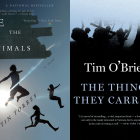Community and Self in the Suburbs
Novelists have been using the suburbs as tender meat for skewering for nearly a century now. Longer, perhaps, if you consider a book like Kate Chopin’s The Awakening, the 1899 novel where we see most of the feelings of desperation and imprisonment that will grow, both in the real world of the suburbs and even more so in their corresponding fictional worlds.
In the middle of the twentieth century, books like Sloan Wilson’s The Man in the Gray Flannel Suit (1955) and Richard Yates’s Revolutionary Road (1961) came along to offer post-war middleclass malaise in full relief. Revolutionary Road has become perhaps the central text on suburban existential angst and is practically required reading for any burgeoning writer in an MFA program. This novel has become such an essential component of our cultural understanding of suburban life that nearly any book set in the suburbs suffers comparisons. And while the book has been deemed a classic by many, it continues to divide people (as do many other suburban novels), as some readers ask, “Why should I care?”
In her book White Diaspora: The Novel and the twentieth-Century American Novel, critic Catherine Jurca argues that the image of the suburbs as a crushing prison has been created and perpetuated as a sort of hegemonic slight of hand. While the man on the 8:14 train is surely one of the most comfortable in the world—well-fed and generally safe from physical and economic dangers—these novels promote the idea that for all the supposed pleasures in his life, this man is actually enduring an existential torture with every cocktail party, every barbeque, every discussion on the evils of crabgrass. “Literary representations of the suburb,” Jurca writes, “propose that white middle-class identity is not grounded in safe havens or homes but in its alienation from the very environments, artifacts, and institutions that have generally been regarded as central to its affect and identity.”
This is all well and good, and the authors of some of the most appreciated suburban novels, I’d guess, would hardly argue. But her main point comes when she asserts that the novels “convert the rights and privileges of living [in the suburbs] into spiritual, cultural, and political problems of displacement, in which being white and middle class is imagined to have as much or more to do with subjugation as with social dominance.” Jurca takes issue, in other words, with the tendency to give the protagonists of these novels the posture of the oppressed, even while they enjoy their substantial cultural allowances.
I like this argument for its psychological and social insight more than I actually agree with it in regards to the American suburban novel. It is surely true that we live in a time when the underdog, even a clearly false one, is prized—while vague, manufactured notions of the “establishment” are strung up for flogging. Career politicians tout their “outsiderness” despite readily available biographies. Daily we watch the news and see the most influential, moneyed, politically dug-in groups claim to be bullied and silenced by those of far less strength and means. It seems to be a fact of the current landscape that all our society’s worst members need do to distract from their own misdeeds is adopt a whiny tone and insistently opine “poor me.” This is the bread and butter served at the tea party. So to speak.
Yet I’m not sure that this is what is happening with the suburban novel. Or at least I don’t think this is why we read (or write) these books. Whether we’re talking about the mid-Century classics of the genre or the more recent works of Jeffrey Eugenides, A.M. Homes, or Tom Perotta, we sympathize with—or at least understand—the characters not because they reinforce some contrived sense of victimhood, but because, regardless of our social or economic situation, we understand the search for meaning and the self.
The struggle for individuality is deeply ingrained in a cultural value system. It always has been. It is one of our greatest fears to find we are not unique or autonomous. Filmmakers often mine these fears over sameness by casting villains as soulless, black-spectacled government agent-types, one interchangeable with the next. Or, more callously, they flash images of identical twins in an attempt to elicit some visceral terror. It can strike a deep nerve to gaze upon the loss of distinction. We shudder.
And so how can we not feel the pangs of existential anxiety when the national—and indeed human—drive to distinguish oneself from one’s neighbor comes into conflict with the simultaneous values of suburban uniformity? Their economic comfort does not prevent us from feeling for these suburban characters; we relate all too well to the dual struggles for belonging and individual identity.
“Economic circumstances might force you to live in this environment,” Yates writes in his 1961 masterpiece, “but the important thing was to keep from being contaminated. The important thing, always, was to remember who you were.” A strange quote. The “economic circumstances” spoken of here, when taking a larger view of the world, involve being relatively well off. And “contamination” may seem a bit melodramatic in the light of significant poverty and struggle found across the globe.
But this is what so much literature is about: yearning for something beyond the material. Love. Honor. Empathy. Knowledge. And in the case of the suburban novel, identity. Even in books where there is a mortal danger to the protagonists, they have something more at stake. Living is not enough. The characters ache for a connection to their own humanity. Also from Yates:
Look what happens when a man really does blow his top. Call the Troopers, get him out of sight quick, hustle him off and lock him up before he wakes the neighbors…The hell with reality! Let’s have a whole bunch of cute little winding roads and cute little houses painted white and pink and baby blue; let’s all be good consumers and have a lot of Togetherness and bring our children up in a bath of sentimentality—and if old reality ever does pop out and say Boo we’ll all get busy and pretend it never happened.
It is the desire of these characters to be human, completely and unapologetically, with all the confusion and contradictions and insecurity that that entails, all the depressions and elations and deaths and births and malodorous bodily functions—and yet still belong to the order of the community. We all struggle to exist as multiple selves that are often at odds with each other: parent and child; teacher and student; healer and disciplinarian; warrior and peacemaker; insider and outsider. The suburbs represent this precarious and ultimately unsustainable equilibrium.
Why do we care about these books? Because of the characters’ struggle for simultaneous and contradictory modes of existence. And because of their tragic, inevitable failure.



